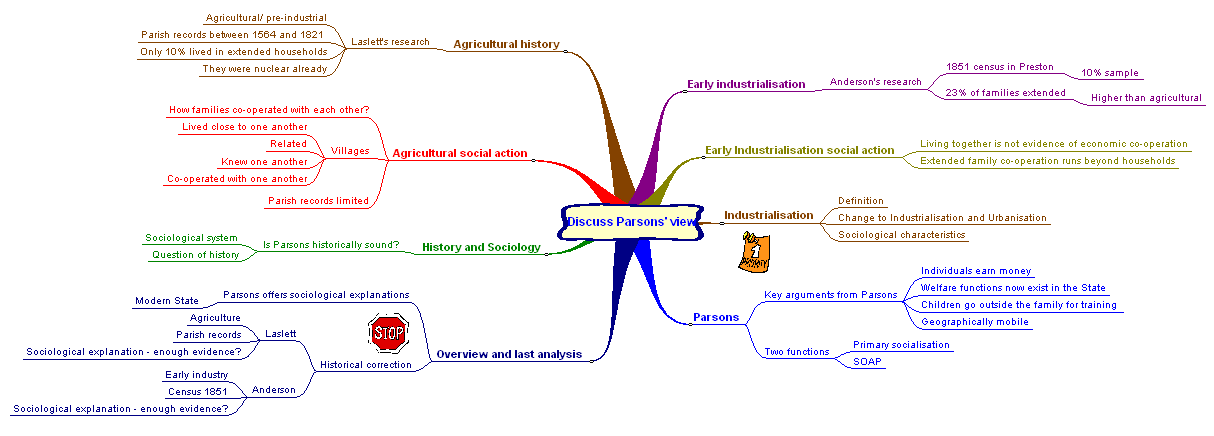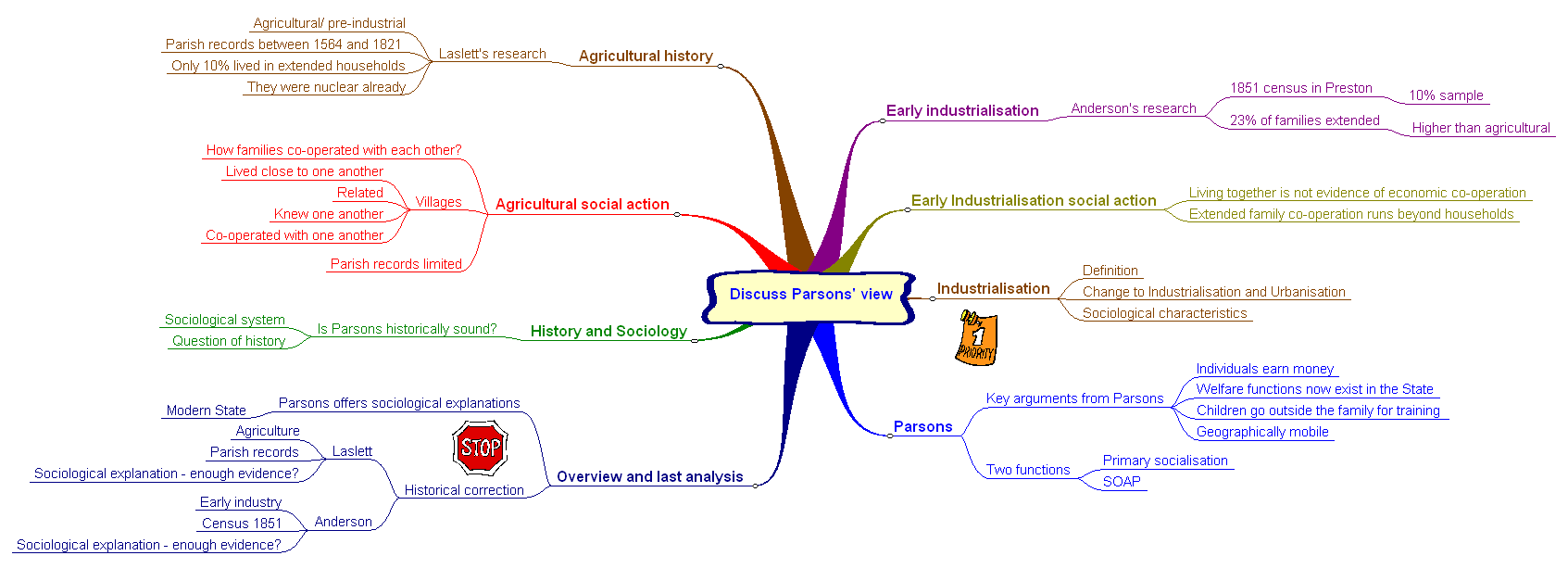
| Exercise: Can these paragraphs be put into the right order (groups or individuals)? |


|
Overview: Parsons is suggesting that the family has become nuclear to fit industrialisation, and that therefore it would have been less nuclear or more extended before industrialisation. This seems not to be the case, according to the findings of Laslett and Anderson.
The essay first needs to define industrialisation (going from the general to the particular) and compare it with the agricultural past. |
|
Change to Industrialisation and Urbanisation: Sociological characteristics (Industrialisation)
Industrialisation began in 1750 with movement of people from agriculture and cottage industries into the towns and towards the "clockwork" regularity of working in large factories. Factories with what was then the new technology of machines and with economies of scale were more efficient and lower priced than people making home produced goods. Towns grew in a process known as urbanisation around the factories. People became more anonymous living in towns compared with villages. They did not have to live near people they knew. |
|
The essay should establish these key arguments first from Parsons (Parsons):
Parsons argues that the isolated nuclear family (married couple and children) has developed through choice and because individuals earn money rather than families together performing as a production unit as in agricultural times. Many supporting welfare functions carried out by the family now exist in the State, such as education, health and support through difficult times. The family has to do less, but specialise in its basic and irreducible functions. Children go outside the family for training into the economy, and so they do not have to do the same work in the next generation. They achieve status through their work, not by where they are in the family and social status. Smaller family units are more geographically mobile. An extended family drags back key individuals to their location, and such families are too bulky to respond to needs to move around for work. |
|
There needs to be a bridging paragraph in order to introduce other sociologists and criticism (History and Sociology):
Parsons raises important sociological arguments but it is important to ask whether this meets the findings of research. Is Parsons' functionalist approach historically sound? |
|
Laslett as a corrective to Parsons (Agricultural History):
Peter Laslett is making important historical points by examining parish records. Between 1564 and 1821 only 10% lived in extended households. What does this say about Parsons argument that people became more nuclear in family arrangement due to industrialisation when they were already in a mainly nuclear group? |
|
Discussion of Laslett (Agricultural Social Action):
The criticism of Laslett is that these records show nothing about how families co-operated with each other. They must in their villages have lived close to one another, and there must have been family co-operation. People were well interrelated given the lack of travel amongst agricultural and cottage industry people who lived their lives in one locality. |
|
Anderson as a continued corrective to Parsons (Early Industrialisation):
Michael Anderson suggests that early industrialisation encouraged extended families. A 10% sample from 1851 census in Preston showed that now 23% of families were extended. They became more extended, Anderson suggests, because there was no welfare state and no possibility of specialisation of family functions. Therefore, in situations of industrialised stress and need, families relied on extended networks. |
|
Discussion of Anderson (Early Industrialisation Social Action):
However, it is again important to say that living together is not evidence of co-operation, and that extended family co-operation runs beyond households. |
|
A conclusion should give an overview and add some analysis (AO2) (Overvbiew and last analysis):
Parsons offers sociological explanations based on the developed modern state. Laslett and Anderson offer historical correction, based on early industrialisation, urbanisation and raw market capitalism. They rely on primary documents of parish returns and census figures, and provide sociological explanation based on these that may not be supported within the evidence. |
| AO1: Knowledge and understanding of the theories, methods, concepts and various forms of evidence, and of the links between them; Communication of knowledge and understanding in a clear and effective manner. Worth 45-55%. |
| AO2: Acquisition and appropriate application of skills of identification, analysis, interpretation and evaluation. Worth 45-55% |
| Source: http://www.aqa.org.uk/qual/pdf/AQA-5191-6191-W-SP-05.pdf |